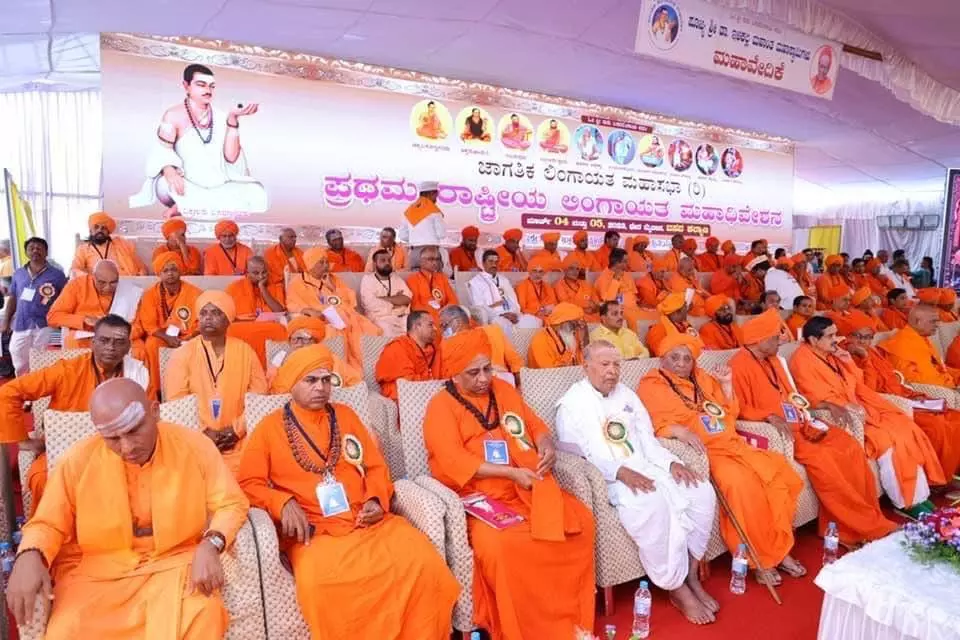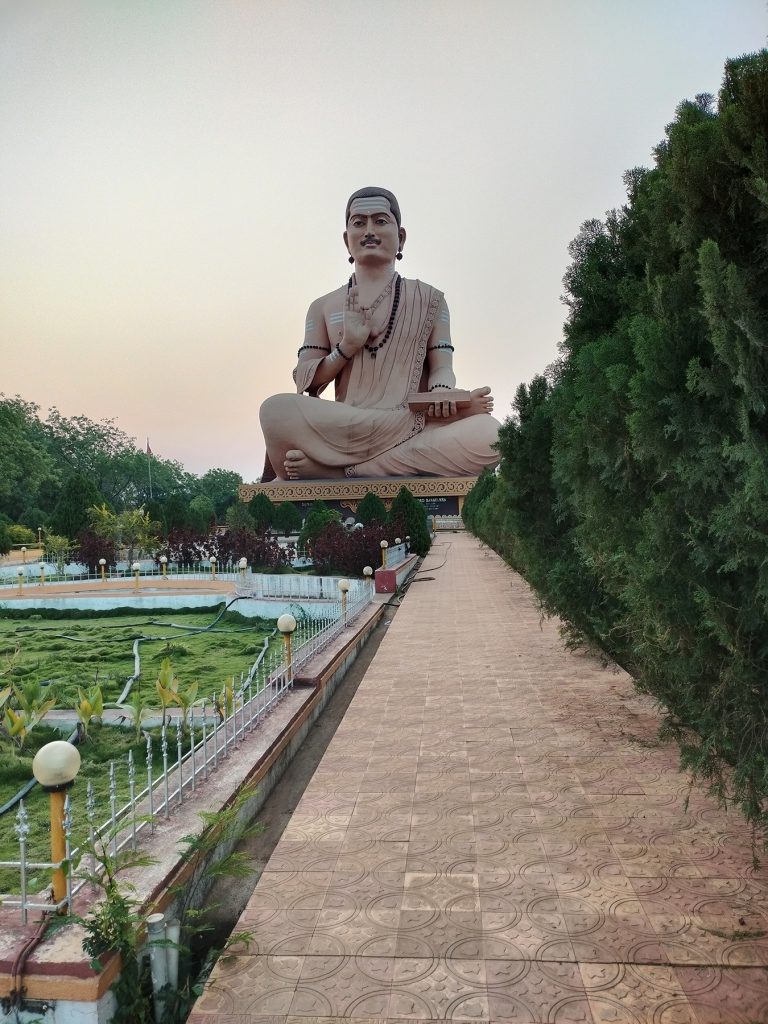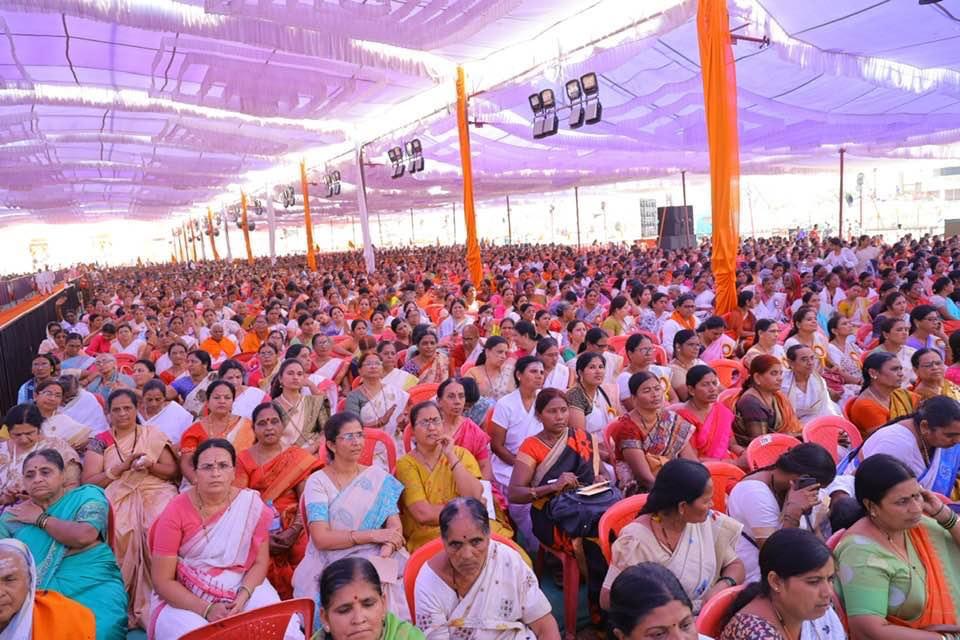
Karnataka: Seeking separate religion, Lingayats return to their radical roots

Addressing a recent Lingayat convention at Basava Kalyan, noted social activist C S Dwarakanth asked the delegates to keep ‘Nagpur cobras’ at bay if they wanted to get a separate religious status for their faith.
The otherwise staid delegates broke into spontaneous applause and whistled to show their approval. After the speech, the convention organisers stepped in and requested a standing ovation. The 25,000-strong audience in the pavilion was happy to oblige.
Read in Kannada: ಪ್ರಗತಿಪರ ತಿರುವು ಪಡೆದ ಪ್ರತ್ಯೇಕ ಲಿಂಗಾಯತ ಧರ್ಮ ಹೋರಾಟ
The convention, Lingayata Maha Adhiveshana, was organised by a relatively new but fast-growing community organisation, Jagathika Lingayata Mahasabha (JLM), to revive the demand for separate religious status for Lingayats, who constitute over 15 per cent of the population in Karnataka.
Controversial start
In the run-up to the convention, JLM had run into an unlikely controversy. A few detractors accused it of organising the event with assistance from the BJP, prompting key invitees like the left-leaning Justice Nagamohan Das and scholar Ramzan Darga to drop out at the last minute.
Dwarakanth provided a moment of epiphany to clarify the ideological moorings of the Lingayat movement that refuses to go away despite facing huge odds.
JLM officials blame the BJP for ambushing them and triggering the controversy. They say they had booked the venue well in advance to hold their event on March 4-5. As D-day approached, BJP leaders sprung a surprise and booked the same venue for March 3 to kick off their election campaign in the region.
BJP workers plastered the town with their publicity materials and even flew in Amit Shah and Yediyurappa to draw attention to the event.
Left with no time, JLM officials say they were forced to pay the contractor to use the same stage built for BJP. “A facility to host 50,000 people cannot be built overnight. If I book a wedding hall for a particular date, I have no say on who uses it on the other dates,” said a JLM leader G B Patil in an interview with a Kannada publication.
JLM officials believe that BJP, which is struggling to hold on to its Lingayat voters, planned to hijack the event and mix up the publicity materials to create an impression that both events were related.
They point out that they are at ideological loggerheads with the Sangh Parivar. Their campaign for a separate Lingayat religion on the lines of Sikhism or Jainism places them in direct conflict with the Sangh Parivar, who want to keep the ‘Hindu’ flock together.
Radical roots of Lingayats
 Lingayats follow the footsteps of social reformer Basava and his peers, who rebelled against Vedic Hinduism and started the Lingayat movement at Basava Kalyan in the 12th century. They are monotheists who worship only a small ‘ishta linga’, carried on their body. They dismiss Vedas, Agamas and Puranas, and instead follow Vachanas, simple sayings composed by the founders of the movement.
Lingayats follow the footsteps of social reformer Basava and his peers, who rebelled against Vedic Hinduism and started the Lingayat movement at Basava Kalyan in the 12th century. They are monotheists who worship only a small ‘ishta linga’, carried on their body. They dismiss Vedas, Agamas and Puranas, and instead follow Vachanas, simple sayings composed by the founders of the movement.
They reject temple worship, varna order, caste distinctions and instead propagate equality of caste and gender. Basava’s movement was open and inclusive and many oppressed groups joined it, unwittingly triggering a bloody backlash from the Kalachuri king and his confidantes. Even now, many backward and Dalit castes in Karnataka and elsewhere trace their social history to the 12th-century movement. Vachana composers from these communities are universally revered by all Lingayats.
Lingayats are acutely aware of their differences with the Vedic norms and still retain many of their distinct ceremonies and rites of passage. For instance, they bury their dead in graveyards that are separate from Hindu burial grounds. But over the centuries, Hindu beliefs and practices have seeped back into the socially and geographically diverse Lingayat groups in varying degrees.
On the one end of the spectrum, you have Veerashaivas, who are probably of Brahminical origin and show a strong influence of Vedic Shaivism. On the other end, you have the groups behind JLM, which are more diverse, subaltern and highly sensitive to their heritage. Veerashaivas treat Basava as one of their many gurus. For Lingayats, Basava is where their journey started and their emotional attachment to him is non-negotiable.
Old demand gaining traction
The demand for a separate Lingayat religion is over a century old, but has gained huge momentum in the last seven or eight years.
Lingayat groups held two major rounds of agitation in the British era but fell silent after Independence, perhaps discouraged by the religious partition of the country and the violent aftermath. In the 1980s, influential Lingayat organisations and leaders began to come alive again and started spreading awareness about the distinctive path shown by Basava.
Scholar M M Kalburgi’s research, which began to come to limelight, would provide the intellectual ammunition to launch the separate religion movement. He meticulously combed through thousands of inscriptions and literary sources to construct an exhaustive history of Lingayats. He brought out their differences with Vedic Hinduism, emphasising the radical streak in their origin.
The coming of the Internet and social media accelerated the campaign further. Hundreds of small organisations sprung up to spread the word through WhatsApp groups, Zoom meetings, conferences and prayer meetings at homes.
There is no parallel in Karnataka in the way Lingayats are mobilising today. There is a non-stop stream of activities in different parts of the state to counter Vedic beliefs and rituals, with simple ceremonies in Kannada and an egalitarian outlook rooted in Lingayat tradition.
Murder of Dr Kalburgi
The assassination of Dr Kalburgi was another event that shook up the community. Lingayat activists travelled across the state and held meetings sharing Kalburgi’s findings, and underlining how the community had chosen to be indifferent to his tragic demise.
A Lingayat social media influencer based in Mysore says he left RSS after attending one such meeting at the Mallana Moole matha in Nanjangud. “I was shocked that my RSS upbringing had made me celebrate Kalburgi’s murder,” he says.
He got in touch with about 40 Lingayats, who similarly left RSS at the time, and started coordinating their social media activities. They came together to pay homage to Dr Kalburgi on his third death anniversary by triggering a national Twitter trend demanding police to speed up the investigation.
“The days of anyone killing a Kalburgi or a Gauri Lankesh are long gone. If it happens again, Lingayats will revolt,” he says.
“Critical thinking Lingayats pose a major challenge to RSS in Karnataka and they are growing,” says J S Patil, who is with the media cell of JLM.
Political turn in 2018
The demand for the Lingayat religion burst into spotlight in 2018 with a few influential Lingayat swamis and non-BJP politicians launching JLM. The Congress government, which was seeking to woo Lingayat votes from the BJP, seized upon the issue, appointed a commission to look into the demand, and promptly forwarded its favourable recommendation to the central government.
In the run-up to the state elections of 2018, Lingayat organisations held back-to-back huge rallies — with politicians supplying the money and the people — to force the central government to consider their demands.
The campaign took off so suddenly that most Lingayats were probably caught unawares like the rest of the society. Key community leaders like Yediyurappa and prominent organisations like All India Veerashaiva Mahasabha (AIVM) opposed the campaign and the separatists were stigmatised as seeking to break the Hindu society.
The religion card failed to shift Lingayat votes from the BJP to the Congress and after the election the politicians dropped it like a hot potato. The movement further fizzled out during the Covid pandemic, which restricted travel and gatherings. It was during the last year that JLM leaders, led by retired IAS officer S M Jamadar, again started touring districts and mobilising people.
Radical speeches at convention
 The convention, which was a culmination of their efforts, kept political parties away and was crowd-funded. It was attended by an estimated 40-50,000 people from different parts of Karnataka, all paying for their own tickets. Speaker after speaker urged Lingayats to return to their 12th-century roots, reject Hinduism and work towards a separate religion and an equitable society.
The convention, which was a culmination of their efforts, kept political parties away and was crowd-funded. It was attended by an estimated 40-50,000 people from different parts of Karnataka, all paying for their own tickets. Speaker after speaker urged Lingayats to return to their 12th-century roots, reject Hinduism and work towards a separate religion and an equitable society.
This discourse ran on these points — Lingayats should develop a secular attitude and stop thinking that they are Hindus (Panditharadhya Shivacharya Swami); Lingayats should interact with backward castes with utmost respect, love and affection (Akka Annapurna Thayi); All of us, Lingayats, were untouchables at one time. We should get rid of temple worship, Tulasi puja, Navagraha puja and yagnas (Nijagunananda Swami); Lingayat religion was built by the working classes, only it can remove caste from Karnataka (Dwarakanath).
In a religious meet and in the presence of 200 community swamis, Jamadar declared that his daughter-in-law was a Christian, to emphasise the inclusivity of the movement.
Agenda of woke leadership?
Many think that JLM leadership is ‘woke’ and out of step with the majority of Lingayats, who show typical upper caste behaviour. A prominent Veerashaiva High Court lawyer derisively described the Basava Kalyan meet as a ‘Woodstock moment’, which would peter out quickly as Lingayats were too steeped in caste and Hindu practices.
Jamadar dismisses the charge, saying awareness has dramatically grown among Lingayats, especially in North Karnataka, in the last five years. “Of the 200 Swamijis on the stage, 16 represented OBC and Dalit communities, and none opposed them. Rich, upper-class Lingayats paid for the convention, and they don’t have a problem,” he said.
The Congress-sponsored 2018 agitation may have failed to fetch votes, but the high-decibel campaign seems to have woken up a large section of the community to the issues of their heritage and identity.
Changes in the community
JLM officials give many examples to show the changes sweeping in the community.
A centuries old feudal practice of carrying swamis sitting cross-legged on palanquins during religious ceremonies is reportedly declining drastically. “Five years ago, the practice was prevalent in hundreds of places. Now it exists only in a handful of locations,” Jamadar says. Swamis are now forced to walk alongside the palanquins. Where Swamis insisted on the old practice, Basava believers forced them to get off and take a walk.
Lingayat marriages, which never followed standard Vedic rituals such as sapta padi, are reportedly changing further. Now they are slowly switching from Sanskrit to Kannada, using Vachanas instead of mantras. “Brides and grooms tie shatshala pendant to each other instead of taali, with the woman taking the lead. More and more Lingayats are marrying inter-sect and inter-caste,” says J S Patil. Shatshala, or six phases, a popular philosophical concept in the Lingayat thought, captures the spiritual progression of a devotee.
Persisting casteism
Critics say not all Lingayats share JLM’s idealism with the same zeal.
The Lingayat movement started in Basava Kalyan in the northern tip of Karnataka and radiated in different directions over the centuries. It particularly snowballed towards central and southern Karnataka, acquiring a huge following along the way. It is held that as you travel towards the south, the movement begins to lose its ideological fervour and the influence of Hinduism becomes more prominent. In the Old Mysore region in southern Karnataka, the Vedic Shaivite influence becomes prominent and Lingayats here are socially more conservative.
A young and upcoming Lingayat swami says casteism is a bane in North Karnataka Lingayats as well. “The North Karnataka Lingayat institutions hire only members of their sub-caste. Bringing in 16 OBC and Dalit swamis on stage was more of a personal initiative of the JLM leadership. I am not sure if Lingayats everywhere would accept them,” he says.
Jamadar concedes that JLM is a work in progress. “Attitudes have calcified over the centuries. They cannot be changed overnight,” he says.
Lingayats vs Veerashaivas
The call for a separate religion would pack a punch if all sections of the Lingayat community come together, though that unity looks like a pipedream at the moment.
JLM and another influential organisation, All India Veerashaiva Mahasabha (AIVM), both of whom are in a contest to represent the community, are increasingly getting entangled in a bitter feud. AIVM wants separate religious tag for both Veerashaivas and Lingayats. JLM argues that including Veerashaivas, who are indistinguishable from Shaivite Hindus, gives an excuse for the governments to reject their demand.
JLM dismisses AIVM, which has influential leaders across parties, as an outfit of power mongers. “We work with people to promote Basava consciousness. They work with parties to get tickets,” says J S Patil. At a recent event, a senior AIVM leader abused Jamadar and addressed him in the singular. JLM leaders say Veerashaivas are more dangerous than Vedic Hindus.
JLM organised the Basava Kalyan convention in partnership with five older and highly resourceful Lingayat organisations. With a rapidly growing membership and an active calendar of activities, JLM seems to be stealing a march over AIVM.
Challenge of reservation agitation
The campaign for separate reservation by individual Lingayat castes, especially Panchamasalis, is also threatening to split open the community. Panchamasalis are aggressively agitating for reservation, stressing their separate status and distinct symbols within the Lingayat community.
“We want to keep Lingayats united, so we are neither in favour nor against anyone’s reservation demand,” says Jamadar without naming the Panchamasalis.
An influential Panchamasali swami was invited but chose to skip the convention.
Existential concern
JLM officials say the demand for separate religious status is not academic but existential. Over the years, the number of people registering as Lingayats in different caste counts has dropped drastically. The Havanur commission found that 18 per cent of the population in Karnataka reported as Lingayats in 1975. The number reportedly dropped to just 9 per cent in the 2015 caste census commissioned by the Congress government.
According to JLM officials, many swamis have misled as many as 18 Lingayat sub-castes, saying they would lose reservation if they did not register as Hindus. So, their followers are registering as Hindu-Sadhu and Hindu-Banajiga instead of Lingayat-Sadhu and Lingayat-Banajiga, for instance.
JLM officials want to counter this trend by working to correct the erroneous impression. “Reservation in India is not given for castes but for social and economic backwardness,” says Jamadar.
The larger issue, JLM says, is that it is so easy to mislead Lingayats and make them lose their identity with flimsy threats or incentives. “Only by mobilising Lingayats into a separate religion, can we strengthen their identity and make them take pride in it,” says Jamadar.
Read in Kannada: ಪ್ರಗತಿಪರ ತಿರುವು ಪಡೆದ ಪ್ರತ್ಯೇಕ ಲಿಂಗಾಯತ ಧರ್ಮ ಹೋರಾಟ


